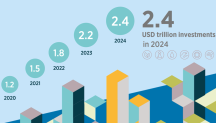

-
-
IRENA (2024), Renewable power generation costs in 2023, International Renewable Energy Agency, Abu Dhabi.
Copied
https://www.irena.org/-/media/Files/IRENA/Agency/Publication/2024/Sep/IRENA_Renewable_power_generation_costs_in_2023.pdf
Copied
Renewable Power Generation Costs in 2023
Newsletter
In 2023, the global weighted average levelised cost of electricity (LCOE) from newly commissioned utility-scale solar photovoltaic (PV), onshore wind, offshore wind and hydropower fell. Between 2022 and 2023, utility-scale solar PV projects showed the most significant decrease (by 12%). For newly commissioned onshore wind projects, the global weighted average LCOE fell by 3% year-on-year; whilst for offshore wind, the cost of electricity of new projects decreased by 7% compared to 2022. Battery storage project costs dropped by 89% between 2010 and 2023.
Power generation from renewable energy technologies is increasingly competitive, despite fossil fuel prices returning closer to the historical cost range. The most dramatic decline has been seen for solar PV generation; the LCOE of solar PV was 56% less than the weighted average fossil fuel-fired alternatives in 2023, having been 414% more expensive in 2010. Also in 2023, the global weighted average LCOE of new onshore wind projects was 67% lower than the weighted average fossil fuel-fired alternative, having been 23% higher than the weighted average fossil fuel-fired equivalent in 2010. The new renewable capacity added since 2000 is estimated to have reduced electricity sector fuel costs in 2023 by at least USD 409 billion, showcasing the benefits renewable power can provide in terms of energy security.
Renewable power generation has become the default source of least-cost new power generation. The progress made in 2023 is a significant step toward transitioning to a system based on energy efficiency and renewable technologies.




